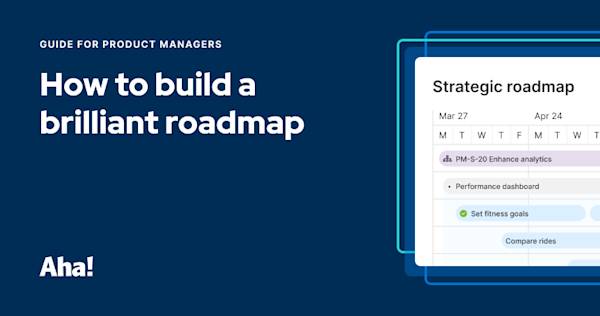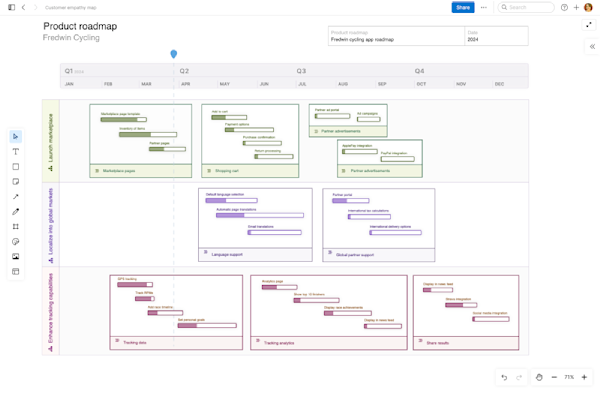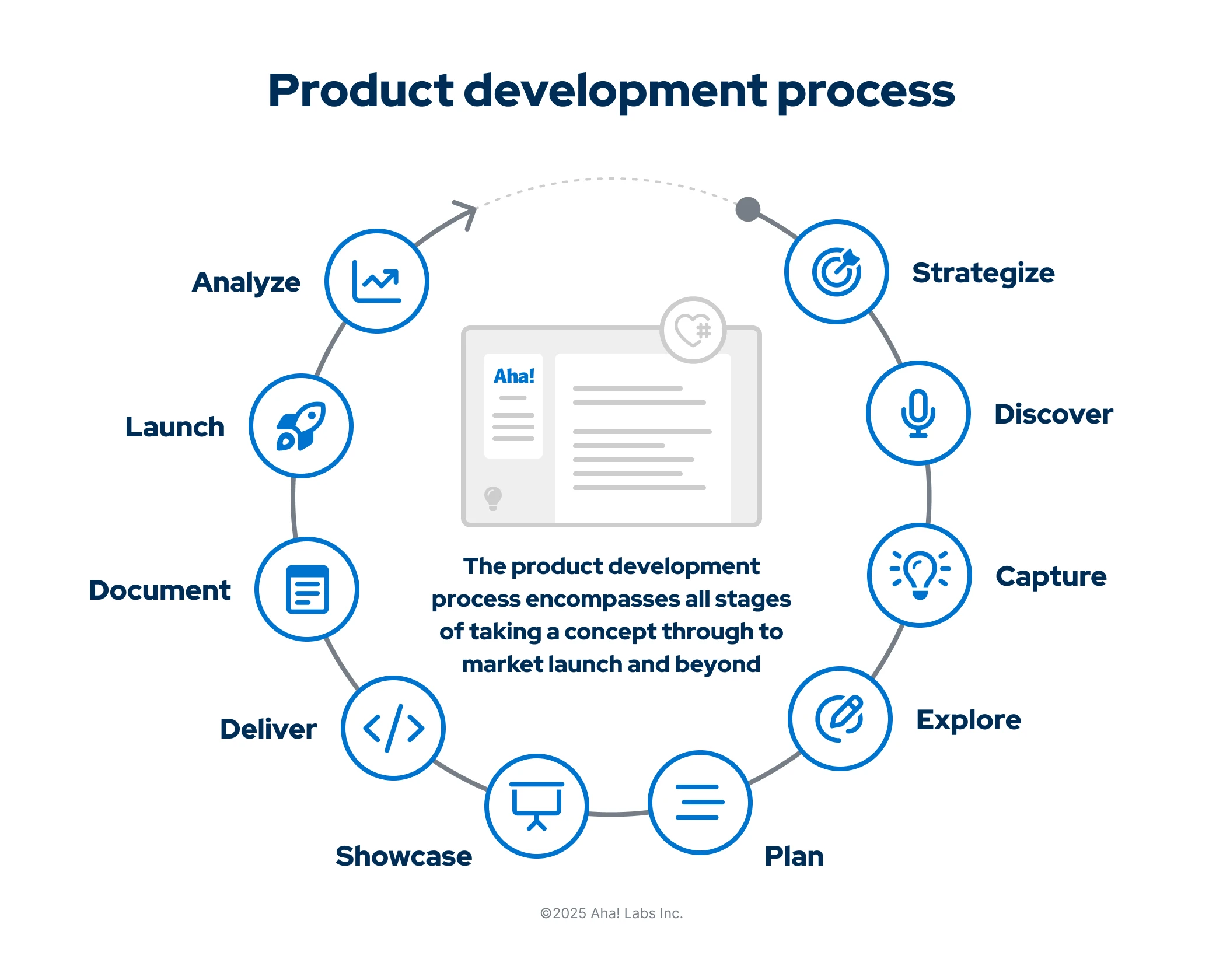You might ask folks to share what activities they feel the organization does extremely well at each stage and what could be improved. This type of lightweight SWOT analysis can be valuable when you are defining the way you want to work. Many product teams also create their own product development workflows using templates that they can update to reflect the unique details of their organization and product.
Related:
Top
Example of a product development process
The product development process should be universal. Regardless of the company or product, you should be engaging in each of the ten steps as part of taking an idea from conception through to market introduction — starting with strategy and moving through to ongoing measurement after launch.
What is an example of the product development process in action? Again, there are 10 steps: strategize, discover, capture, explore, plan, showcase, deliver, document, launch, and analyze. Some folks want tangible examples from successful technology companies. You can look for examples of product development processes to see how products are developed at name-brand companies such as Apple, Google, Netflix, or Spotify.
High-performing product-led organizations have one thing in common: They invest in helping teams be productive and deliver value. Typically, these organizations have unique (and even proprietary) frameworks that shape the way they work. But ultimately, they through the same ten stages — albeit in different ways.
Top
What is a product manager’s role in the product development process?
Product managers hold a unique position. You are responsible for guiding the product development process through to a positive outcome for your company and customers. However, you must do so often without explicit authority over those who contribute to that process.
If you are new to product management, are starting as a product manager at a new organization, or simply wish to better understand what is expected of product managers throughout the product development process, this section is for you.
We will go deeper into each phase, outlining responsibilities and typical work items, sharing how-to guides, and adding helpful templates that are sure to benefit you. You can also scroll down for a summary table that you can use for quick reference.
1. Strategize: Establish a clear vision and goals
Most of the foundational strategic work is owned by company leaders in collaboration with a chief product officer, VP of product, and senior product managers. Together, you set the top-level goals and initiatives that will influence the product team's areas of focus.
The strategy phase of product development includes crucial work such as establishing positioning and messaging, conducting market and competitor analysis, and developing user personas that clearly describe specific segments of your target market. This foundation helps bring the customer's voice into everyday decisions.
At a single-product company, product and company goals might be the same. And at organizations with a portfolio of products, each product will have its own goals and initiatives. Product managers are responsible for delivering against the defined product strategy and ensuring that the product team's work tracks back to these top-level goals.
How-to strategy guides for product managers
Strategy templates for product managers
2. Discover: Interview customers to uncover insights
Customer interviews reveal what strategy alone cannot: the deeper context behind what people truly need. Product managers lead discovery efforts, conducting customer interviews to understand their behavior, pain points, and preferences. These conversations provide clarity on what customers truly need and shape what comes next.
Use this stage to establish research best practices, expand the pool of people you hear from, and streamline how product and user research teams engage with customers. Document what you learn in a centralized research database to make it easier to spot patterns and share insights across the team. When you link those findings directly to your roadmap, you give the company confidence that its invested resources can solve real problems.
How-to discovery guides for product managers
Discovery templates for product managers
3. Capture: Centralize customer feedback
Putting strategy into action is hard work. Plenty of people within and outside the organization will have an opinion about what you should do next, and these ideas and requests are essential for innovation.
This is why this phase of product development hinges on product managers investing in idea management. It is the product team's responsibility to review and evaluate ideas from customers, colleagues, and partners.
When you centralize customer feedback, you can collect, review, and score requests consistently and transparently. The focus should be on transforming concepts into real solutions that are aligned with business and customer needs.
How-to idea management guides for product managers
Idea management templates for product managers
4. Explore: Brainstorm and refine ideas on a whiteboard
It is now time for conceptual thinking. Using a whiteboard tool to make your thoughts visible is useful at nearly every stage of product development, but is especially important when you are exploring new ideas.
Product managers are responsible for leading brainstorming meetings and ensuring the team stays focused on identifying approaches that are in line with product goals and customer needs. Depending on the size of your organization and team, you might also start sketching out new features or create wireframes to demonstrate how functionality could work.
How-to ideation guides for product managers
Ideation templates for product managers
5. Plan: Prioritize features, estimate value, and manage capacity
After exploring comes refining ideas further based on goals, estimated product value, and your team's capacity. In this stage, product teams shift into detailed roadmap planning led by the product manager. This includes defining the epics, major user stories, and features that fit under each initiative. Keep in mind that your product roadmap is different from your release plans (they detail phases of work, release dates, and dependencies).
A product value scorecard gives you consistent criteria for estimating the value of ideas, refining during feature scoping, and then measuring again after release. Establish a prioritization framework and value metrics that can be used consistently across teams and stages.
After building the roadmap, you need to detail how the tactical work will get done. Collaborating with engineering on how much effort it will take to complete upcoming work is a critical piece of making your roadmap a reality. This is where capacity planning becomes critical. You need to balance your ambitious plans with the resources available to complete the scope of work.
How-to planning guides for product managers
Planning templates for product managers
6. Showcase: Share roadmap views and go-to-market plans
Roadmaps serve as a communication tool for internal and external groups. And getting buy-in and anchoring the team around a shared vision requires everyone to know their role in the product's success.
During a roadmap presentation, the product manager shares roadmap views tailored to the audience. For instance, whereas company leaders will want to understand how major initiatives roll up into company strategy, the customer support team will want to see the benefits of upcoming functionality, guidance on when it will be available, and tips on how to introduce it to customers.
Showcasing the roadmap also involves more than unveiling new features and a timeline. Product teams can use this phase as an opportunity to introduce early go-to-market plans and support team alignment before releasing new functionality.
How-to roadmap presentation guides
Roadmap presentation template
7. Deliver: Manage engineering and rollout activities
In this stage, the team’s focus shifts from planning to delivery. Product managers work with engineering, operations, IT, and marketing to review the details of what is planned — from features and requirements to rollout and readiness.
Engineering typically leads the development work (estimation, sprint planning, acceptance criteria). Operations and IT ensure new capabilities are implemented and supported internally. Marketing prepares the go-to-market activities needed for launch. The product manager validates that all of these streams remain tied back to the goals set in the roadmap.
Agile development is common for engineering teams, while other groups follow their own project methods. Whatever the approach, all delivery work must stay coordinated so the product is delivered smoothly end-to-end.
How-to agile development guides for product managers
Agile development templates for product managers
8. Document: Create a knowledge base
Although you might not be responsible for creating customer-facing materials, cross-functional teams will rely on your product expertise to craft the right messages and content. Leverage all of the product information you have documented throughout the development process to deliver the content resources colleagues and customers need for success.
The advent of AI writing tools is a boon to product managers. You can quickly create documentation, technical instructions, release notes, and other self-help resources using material you already wrote during product planning.
One of the best ways to ensure this product knowledge is accessible and updated is to publish wikis within a knowledge base site. These can be private to internal teams or public for customers.
How-to documentation guides for product managers
Documentation template for product managers
9. Launch: Bring exciting new capabilities to market
Product managers are responsible for coordinating the releases and launches that bring a new product experience to market once it is ready. Regardless of your release cadence, you need to consider all of the cross-functional activities needed to support the release — from marketing and promotions to customer support.
Remember: A product launch is not a single event that gets wrapped up in a day or two. It requires just as much planning as any other stage in the product development process.
Depending on the type or size of the release, launch activities might include making marketing announcements, providing customer-facing or internal training, and more. Consider creating your own launch checklist to align the team around the work that needs to get done.
How-to launch guides for product managers
Launch templates for product managers
10. Analyze: Assess realized product value by tracking customer use and love
Successful launch done. On to the next? Not so fast. Important post-launch work includes analyzing product usage and gathering customer feedback. There are some standard product metrics you might track, but numbers alone cannot tell the whole story.
The metric that Aha! uses to measure realized value is lovability: how much your customers truly love a product and want to tell others about it.
You can measure lovability in various ways, including with a simple in-app survey that asks customers to rate their overall satisfaction. Some product teams also use metrics such as net promoter score or customer satisfaction score.
Product managers typically build dashboards to monitor both product usage metrics and customer sentiment. Tracking and reporting on KPIs serves a few purposes. First, you are able to understand whether your assessment of potential value in stage four was accurate. Second, you can share how the product is performing in market with executive stakeholders and teammates. Third, you can take those learnings and improve the way you assess potential value going forward — spotlighting opportunities that might not have been obvious in the last iteration.
How-to product value guides for product managers
Top
Product development process activities and deliverables
The following table outlines some of the most common activities and associated deliverables that a product manager and team complete during the product development process.
Stage of product development | Activities | Deliverables |
Strategize | Establish a clear vision and goals. Research market opportunity. Complete competitive analysis.
| Product vision Product goals Product initiatives SWOT analysis Product positioning User personas
|
Discover | | |
Capture | Centralize customer feedback. Set up a portal for collecting ideas. Define customer segments.
| Ideas portal Customer segments
|
Explore | | Mockups and wireframes Proof of concept
|
Plan | Prioritize features. Estimate value. Manage capacity.
| User stories Product backlog Release plan
|
Showcase | | Product roadmap Roadmap presentation Go-to-market strategy
|
Deliver | Deliver functionality and supporting work across teams. Coordinate engineering, operations, IT, and marketing efforts. Provide feedback and ensure alignment to the plan.
| |
Document | | Release notes Product wikis Technical materials Support documents Sales enablement
|
Launch | Bring exciting new capabilities to market. Launch a marketing campaign. Support organizational readiness.
| Product messaging Launch announcement Ads Distribution channels
|
Analyze | | |
Top
How to optimize the product development process
Product development practices evolve over time. Whether you are just getting started or are refining an existing workflow, optimizing your product development process is a vital part of continual improvement.
If your product team follows a specific product development methodology (such as scrum), you might have built-in checkpoints for evaluating the effectiveness of the team’s output. Those do not supplant the need for dedicated optimization efforts to the overall product development process.
The five steps outlined below show a basic flow that product teams can follow to optimize the product development process:
1. Discuss and agree on processes
Refer back to the visual or written documentation your team created. Discuss the details within each stage. Are there any consistent roadblocks? Areas of tension or dysfunction? Work together to find solutions and agree on any updates as a group.
2. Define roles and responsibilities
Product team members should have clarity around their roles in the process. Review roles and responsibilities, especially as related to any speed bumps revealed in step one. Ask for verbal commitments to the duties defined and honor the critical role each group plays in product success.
3. Assess success metrics
Performance is a very real dimension of product success. Do you have the right product goals in place? Is the team aware of how product value will be measured in production and in market?
Tooling is another dimension to consider. The product development process you define requires cohesion. Is the team using a purpose-built product development tool that allows for tracking at every stage of the process?
5. Incorporate learnings
Reflect on the process after each major release or go-to-market launch. Take what you have revealed through each of the prior steps and see where you can immediately refine your approach. Just as you strive to continually improve your product, you want to give the same level of care and attention to the processes behind it.



